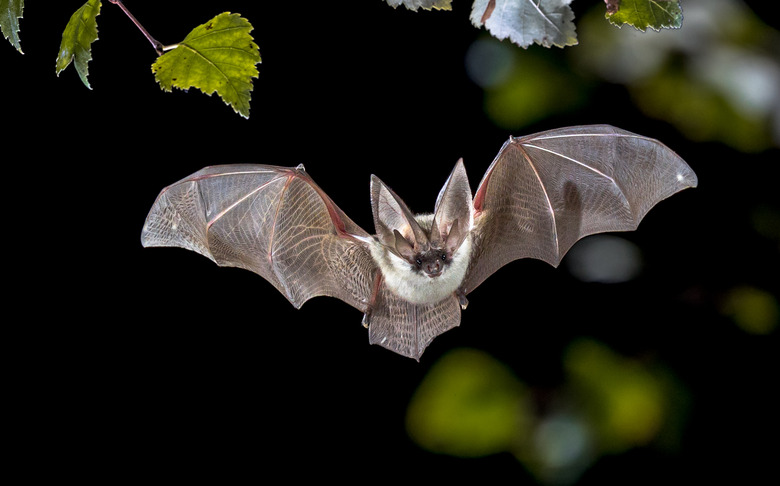Bat Species Found In North Georgia
Of the more than 1,200 species of bats worldwide, 47 species of bats live in the United States and 14 of those are found in North Georgia, according to Bat Conservation International. Most bats hunt insects, helping to control pests that might harm the food supply. Others feed on plant nectar and help in pollination. Bats are mammals in the Chiroptera family, which means hand wing, and are the only mammals to fly.
Most Common
Most Common
The little brown bat is found across North America and is the most commonly found bat in North Georgia attics. About 3.5 inches long, they are brownish with a lighter-colored underside. The most common bats roosting in North Georgia caves, such as Ellison's Cave, Pettijohn's Cave and Byers Cave are the Eastern Pipistrelle, also called the tri-colored bat. The Eastern Pipistrelle is a small, pale yellowish-brown bat, just over 3 inches long and they hibernate in caves in the winter.
Bats Named for their Color
Bats Named for their Color
Big brown bat, silver-haired bat, eastern red bat and the hoary bat all live in, or migrate through, North Georgia. The big brown bat is found most commonly in North Georgia's forested areas and in suburban areas near farmland. Silver-haired bats also live and hibernate in forests. The distinctive eastern red bat has long, silky pale orange fur protecting them from the cold. One of the America's largest bats, the hoary bat has long, dense fur with a frosted-looking white tip.
Myotis Family
Myotis Family
All bats in the Myotis ("mouse eared") family have dark backs and pale undersides. The gray, eastern small-footed, little brown, and Indian myotis bats live in North Georgia. The eastern small-footed bat, the smallest bat in the U.S., has a black facial mask and has a foot that is less than a third of an inch long. The tiny bats hibernate in caves.
Mexican Free-tailed, Seminole and Evening Bats
Mexican Free-tailed, Seminole and Evening Bats
Although Mexican free-tailed bats are found in North Georgia, the majority occupy habitats in the Western U.S. and Mexico in limestone caves, under bridges, in buildings and hollow trees. The Seminole bat roosts in clumps of Spanish moss in the Southern U.S. Evening bats are common in the Southeastern U.S. and live in the forest. They migrate to areas in the Deep South, like North Georgia, in the winter.
Threatened species
Threatened species
The Indiana Myotis is one of the first bat species in the U.S. to be recognized as endangered, according to Bat Conservation International. Rafinesque's big-eared bat population is declining as they often roost in caves that are now being explored by people or in abandoned mines that are being reclaimed and re-opened. These distinctive bats with their disproportionately large ears are slow but agile flyers. The gray Myotis. found in nine caves each winter including one in North Georgia, is on the U.S. Endangered Species List. These bats may accidentally drop their young when their roosting cave is disturbed by human visitors. The Indiana Myotis, also on the U.S. Endangered Species List, is likewise susceptible to human disturbance.
Cite This Article
MLA
Davidson, Elaine. "Bat Species Found In North Georgia" sciencing.com, https://www.sciencing.com/bat-species-found-north-georgia-8356684/. 22 November 2019.
APA
Davidson, Elaine. (2019, November 22). Bat Species Found In North Georgia. sciencing.com. Retrieved from https://www.sciencing.com/bat-species-found-north-georgia-8356684/
Chicago
Davidson, Elaine. Bat Species Found In North Georgia last modified March 24, 2022. https://www.sciencing.com/bat-species-found-north-georgia-8356684/
